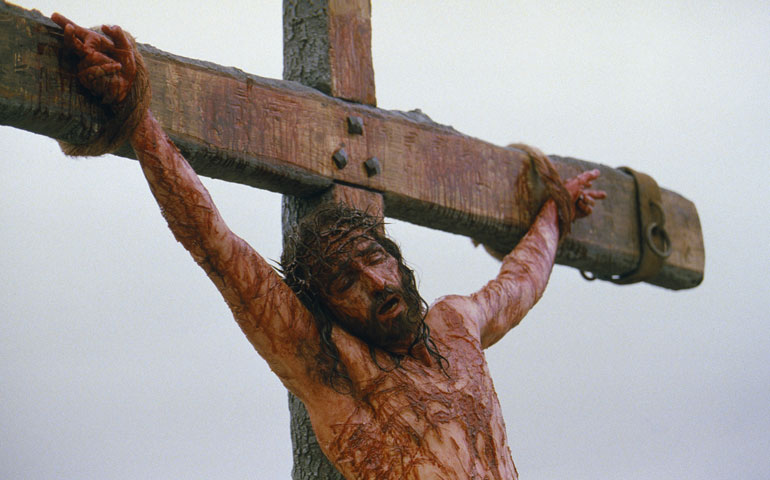
Actor Jim Caviezel portrays Jesus on the cross in a scene from "The Passion of the Christ." (CNS/Icon)
Feb. 25 will mark the 10th anniversary of the release of Mel Gibson's hugely successful and controversial "The Passion of the Christ."
Right after Christmas, I had the opportunity to sit down with two friends, Rabbi Yitzchok Adlerstein, director of interfaith affairs at the Simon Wiesenthal Center in Los Angeles, and Yvonne Gomez, a Christian research consultant, to watch "The Passion of the Christ."
Back in 2004, I reviewed "The Passion of the Christ" as a horror film, and this upset many of my readers. Further viewings of the film confirm that Gibson uses many horror motifs, including the isolation in the garden, the eerie darkness, protruding eyes of children taunting Judas, the worm crawling from the devil's nose, and so forth.
But on this day, the plan was to stop the film for comments from Adlerstein and Gomez when scenes reflected anti-Semitism.
Before the private screening, Adlerstein said about the release of "The Passion of the Christ" in 2004: "The Jewish community probably overreacted at the time, and the reason for this was more than defensible because there were stirrings of a global resurgence of anti-Semitism, and events of the last 10 years unfortunately bear out those misgivings."
Adlerstein also said Gibson "packaged this as the only authentic film about the Passion. It has a veneer of authenticity, but you can find things along the way, such as an artificial distinction between Jews and Romans, that contradict his assertion. The Romans were merciless and criminal, but there was nothing likable in any of the Jews except Jesus and his close followers. Romans who are viciously portrayed are in the business of being heartless, whereas that is not the case in society with priests. The Romans who abuse Jesus are prison guards and soldiers whose duty it is to inflict floggings and other cruel punishments. Priests normally are not, and yet the priests in 'The Passion of the Christ' show themselves as having their own bloodlust."
He also noted Gibson's refusal to bring on board Jewish scholars as consultants, something Adlerstein deemed necessary because "we were afraid of the consequences [of] the impact of this imagery."
This idea prompted me to create an online survey to learn the dominant visual image people think of when they recall "The Passion of the Christ." I wanted to see if people came away with a negative view of the Jewish people. While this is an unscientific survey, I think it shows that most respondents looked at the film uncritically and viscerally; few considered how Jews might view the film.
I asked six questions that 124 people answered; they all had to reply to each question in order to move to the next one.
1. How old were you when you saw the film for the first time?
- The average age was 47.4 years.
2. When you think of the film, what is the first image that comes to mind? (Don't think about it or edit your response -- just describe the first image that comes to mind.)
- Scourging and gore: 30
- Blood: 22
- Crowning with thorns: 6
- Agony in the garden: 4
- Cover of the DVD or poster: 3
There was some overlap in the responses, and the rest mentioned scenes with Jesus and Mary at home, various images of Mary during the Passion and death, the Last Supper, the devil, Jesus writing in the dirt, the birds pecking out the eyes of the men crucified with Jesus, the love shown through Jesus' eyes, Mel Gibson. One person said it was "torture porn," a view I have heard often.
One mentioned the tear that fell from the cross and the earthquake, which is significant because the scene shows the destruction of the temple at the time of Jesus' death, but the destruction did not happen until A.D. 70. According to Gomez, this scene points to a "replacement theology," upholding the mistaken medieval idea that Christianity (Ecclesia) has replaced Judaism (Synagoga). The brokenness visible in the temple evokes the brokenness of Synagoga. In other words, it's a "dig" at Judaism that does not appear to be there by accident.
3. What is your favorite movie about Christ and why?
- "The Passion of the Christ" came out on top (44) and those who listed reasons seem to believe the film is accurate, although analysis has shown this not to be the case.
- None: 19
- "Jesus of Nazareth": 16
- "The Gospel According to St. Matthew": 6
- "Jesus Christ Superstar": 5
- "King of Kings": 5
- "The Gospel of John": 3
- And a variety of others from "Jesus of Montreal" to "The Nativity Story"
4. What was your response to "The Passion of the Christ" the first time you watched it?
- Other: 68
- Liked it: 53
- Disliked it: 17
- Too violent: 16
- It was just as I always imagined the passion and death of Jesus to be: 15
Under "Other," the comments included the film being a masterpiece and moving, even to an atheist who cried and didn't know why. Yet a few took a more critical stance:
"It was highly offensive. It positioned the Jewish leaders as a soulless mafia, the apostles and Jesus as outside of Jewish religious life, and the Jewish people as unanimously involved in eagerly seeing Jesus tortured and murdered."
"I am deeply disturbed that the movie is used to propagate the faith. While the movie attempted to provide a 'real picture' of the suffering of Christ, the focus on Jesus suffering overshadowed his life and why he would embrace this death. Not to mention the anti-Jewish overtones."
"I regret that the wide success of the film has generated misleading cultural images of Jesus for a generation or more."
5. In 1988, the U.S. Conference of Catholic Bishops issued guidelines for the depiction/dramatizations of the passion and death of Jesus in "Criteria for the Evaluation of Dramatizations of the Passion." If you can, take some time to read the document. How well do you think "The Passion of the Christ" 1) creates bonds between Christians and Jews and 2) avoids stereotypes and false impressions? Please explain your answers.
None of the responders acknowledged reading the document but felt compelled to reply just the same. One mentioned Nostra Aetate, the "Declaration on the Relation of the Church to Non-Christian Religions" of the Second Vatican Council. Responders were divided, some saying no bond was created and why, while others thought the criticism of the film by Jews unfounded.
Question 6 asked for the name of the respondent and permission to use it if needed.
Gibson made a film that confirmed many stereotypes of the Jews, such as depicting the moment when the bag of silver was tossed to Judas in slow motion and Judas looked at it lovingly; the "bad" Jewish men with fang-like teeth and the "good guys" with nice teeth; the sneering hatred from the high priest when he questions Jesus; and Pilate calling the Jews "filthy rabble." Certainly not the first to do so, Gibson uses stereotypes, some more subtle than others, to create a group of "bad" Jews to confront the "good" Jews consisting of Jesus, Mary and their followers who would be thought of as aligned with Christians today.
That Gibson was making a conscious choice to reject and negate Judaism is indisputable when we see the sign on the cross. "Jesus of Nazareth, King of the Jews" is written only in ecclesial Latin and Aramaic. He rejects the Greek as detailed in John 19:20, and Greek was the common language of the Roman Empire at that time. Thus, according to Adlerstein, Gibson creates "a tension between Aramaic/Hebrew; he does not create a bond but severs it."
There is no doubt of the Catholic church's respect for and ties with Judaism. On April 13, 1986, Pope John Paul II made the first recorded visit to a synagogue and embraced the world's Jews as "our elder brothers."
According to a March 1, 2013, blog for The Jerusalem Post, Pope Benedict XVI's "was a memorable papacy of mostly positive relations with the Jews. During his tenure Benedict made a series of important, defining statements on anti-Semitism and the Holocaust."
On Sept. 4, Pope Francis wrote a letter to Eugenio Scalfari, an atheist and journalist who writes for the Italian paper La Repubblica, replying to an article Scalfari had written asking, among other things, "what should be said to the Jewish brethren concerning the promise that God made to them: Is that an empty promise?"
"What I can tell you, with St. Paul, is that God has never neglected his faithfulness to the covenant with Israel." The pope also expressed concern about the rise of anti-Semitism in Europe.
Adlerstein expressed concern that "The Passion of the Christ" represents the enduring image of Judaism to the present and coming generations.
"The fact is," Adlerstein said," that there are two movies here: one that Christians see and one that Jews see. I don't know if this can ever change."
[Sr. Rose Pacatte, a member of the Daughters of St. Paul, is the director of the Pauline Center for Media Studies in Los Angeles.]



